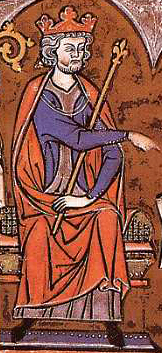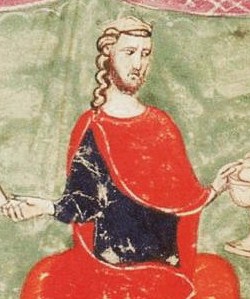Sources
- Ghisalberti, Alberto M., ed. Dizionario Biografico degli Italiani: III Ammirato – Arcoleo. Rome, 1961.
Vinciguerra d'Aragona was the eldest son of Sanciolo d'Aragona and Lucia Palizzi. His father was an illegitimate son of Frederick II of Sicily.
In 1355 he rebelled against his cousin Frederick III, who in December sent him to Patti as Captain to serve until December 1356. With Guerao Gullielm De Sidot and Corrado Spadafora, the captain and castellan of Lipari, he joined his younger brother Sancho (Sanciolo) in a pro-Angevin revolt in 1357. In March 1359 he fell out with Anjou and helped his cousin the king put down what remained of the insurrection. He was rewarded with the lordship of Termini and the county of Novara, which had been his maternal grandfather's, in 1364. From his nephew Mattiotto, the son of Sancho, he inherited the county of Cammarata in 1369. In 1371 he became Baron of Militello, his own father's barony, and San Marco. From 1365 to 1368 he acted as Grand Chancellor of Sicily, replacing Enrico Rosso. He left as his heir his son Bartholomew.
A fortress Vinciguerra built in 1366, the Torre Vinciguerra, in Gioiosa Marea, still bears his name; he also built a castle on the top of Gioiosa Guardia.

The Hohenstaufen dynasty, also known as the Staufer, was a noble family of unclear origin that rose to rule the Duchy of Swabia from 1079, and to royal rule in the Holy Roman Empire during the Middle Ages from 1138 until 1254. The dynasty's most prominent rulers – Frederick I (1155), Henry VI (1191) and Frederick II (1220) – ascended the imperial throne and also reigned over Italy and Burgundy. The non-contemporary name of 'Hohenstaufen' is derived from the family's Hohenstaufen Castle on Hohenstaufen mountain at the northern fringes of the Swabian Jura, near the town of Göppingen. Under Hohenstaufen rule, the Holy Roman Empire reached its greatest territorial extent from 1155 to 1268.

James I the Conqueror was King of Aragon, Count of Barcelona and Lord of Montpellier from 1213 to 1276; King of Majorca from 1231 to 1276; and Valencia from 1238 to 1276. His long reign of 62 years is not only the longest of any Iberian monarch, but one of the longest monarchical reigns in history, ahead of Hirohito but remaining behind Queen Victoria and Ferdinand III of Naples and Sicily. He saw the expansion of the Crown of Aragon in three directions: Languedoc to the north, the Balearic Islands to the southeast, and Valencia to the south. By a treaty with Louis IX of France, he achieved the renunciation of any possible claim of French suzerainty over the County of Barcelona and the other Catalan counties, while he renounced northward expansion and taking back the once Catalan territories in Occitania and vassal counties loyal to the County of Barcelona, lands that were lost by his father Peter II of Aragon in the Battle of Muret during the Albigensian Crusade and annexed by the Kingdom of France, and then decided to turn south. His great part in the Reconquista was similar in Mediterranean Spain to that of his contemporary Ferdinand III of Castile in Andalusia. One of the main reasons for this formal renunciation of most of the once Catalan territories in Languedoc and Occitania and any expansion into them is the fact that he was raised by the Knights Templar crusaders, who had defeated his father fighting for the Pope alongside the French, so it was effectively forbidden for him to try to maintain the traditional influence of the Count of Barcelona that previously existed in Occitania and Languedoc.

Peter III of Aragon was King of Aragon, King of Valencia, and Count of Barcelona from 1276 to his death. At the invitation of some rebels, he conquered the Kingdom of Sicily and became King of Sicily in 1282, pressing the claim of his wife, Constance II of Sicily, uniting the kingdom to the crown.

Frederick II ; 13 December 1272 – 25 June 1337) was the regent of the Kingdom of Sicily from 1291 until 1295 and subsequently King of Sicily from 1295 until his death. He was the third son of Peter III of Aragon and served in the War of the Sicilian Vespers on behalf of his father and brothers, Alfonso ΙΙΙ and James ΙΙ. He was confirmed as king by the Peace of Caltabellotta in 1302. His reign saw important constitutional reforms: the Constitutiones regales, Capitula alia, and Ordinationes generales.

Charles II, also known as Charles the Lame, was King of Naples, Count of Provence and Forcalquier (1285–1309), Prince of Achaea (1285–1289), and Count of Anjou and Maine (1285–1290); he also was King of Albania (1285–1294), and claimed the Kingdom of Jerusalem from 1285. He was the son of Charles I of Anjou—one of the most powerful European monarchs in the second half of the 13th century—and Beatrice of Provence. His father granted Charles the Principality of Salerno in the Kingdom of Sicily in 1272 and made him regent in Provence and Forcalquier in 1279.

Maria was Queen of Sicily and Duchess of Athens and Neopatria from 1377 until her death.

Martin the Humane, also called the Elder and the Ecclesiastic, was King of Aragon, Valencia, Sardinia and Corsica and Count of Barcelona from 1396 and King of Sicily from 1409. He failed to secure the accession of his illegitimate grandson, Frederic, Count of Luna, and with him the rule of the House of Barcelona came to an end.

James II, called the Just, was the King of Aragon and Valencia and Count of Barcelona from 1291 to 1327. He was also the King of Sicily from 1285 to 1295 and the King of Majorca from 1291 to 1298. From 1297 he was nominally the King of Sardinia and Corsica, but he only acquired the island of Sardinia by conquest in 1324. His full title for the last three decades of his reign was "James, by the grace of God, king of Aragon, Valencia, Sardinia and Corsica, and count of Barcelona".

Richeza of Poland was a Polish noblewoman of the House of Piast in the Silesian branch. By her marriages she was Queen consort of Galicia, León and Castile, Countess of Provence, and Countess of Eberstein.

Walter III of Brienne was a nobleman from northern France. Becoming Count of Brienne in 1191, Walter married the Sicilian princess Elvira and took an army to southern Italy to claim her inheritance. He became Prince of Taranto in her right in 1201 but died fighting before he could establish himself as King of Sicily.

Sancho, called the Pacific or the Peaceful, was King of Majorca, Count of Roussillon and Cerdanya, and Lord of Montpellier from 1311 to his death. His 13-year-long reign was markedly undisturbed by turmoil, which earned him his epithets, and is thus often contrasted to the troublesome reigns of his father, James II, and nephew, James III, his predecessor and successor respectively.

Albert II, the Degenerate was a Margrave of Meissen, Landgrave of Thuringia and Count Palatine of Saxony. He was a member of the House of Wettin.

Marcantonio II Colonna, Duke of Tagliacozzo and Duke and Prince of Paliano, was a Roman aristocrat who served as Viceroy of Sicily in the service of the Spanish Crown, general of the Spanish forces, and Captain General of the Church. He is best remembered for his part as the admiral of the Papal fleet in the Battle of Lepanto. He was "one of the most illustrious land and sea captains of the 16th century".

Militello Rosmarino is a comune (municipality) in the Metropolitan City of Messina in the Italian region Sicily, located about 120 kilometres (75 mi) east of Palermo and about 80 kilometres (50 mi) west of Messina.
Constance of Aragon was an Aragonese infanta who was by marriage firstly Queen of Hungary, and secondly Queen of Germany and Sicily and Holy Roman Empress. She was regent of Sicily from 1212 to 1220.
The County of Malta was a feudal lordship of the Kingdom of Sicily, relating to the islands of Malta and Gozo. Malta was essentially a fief within the kingdom, with the title given by Tancred of Sicily the Norman king of Sicily to Margaritus of Brindisi in 1192 who earned acclaim as the Grand Admiral of Sicily. Afterwards the fiefdom was passed from nobleman to nobleman remaining as a family possession in a few instances. It was used mainly as a bargaining tool in Sicilian politics leading to a rather turbulent history. The fiefdom was elevated to a Marquisate in 1392 and either title was no longer used after 1429.
Bartolomeo d'Aragona was a Sicilian statesman, the eldest son and heir of Vinciguerra d'Aragona. His surname derives from the fact that he was a great-great-grandson of Peter III of Aragon in the male line.
Peter was the son and heir apparent of Queen Maria and King Martin I of Sicily. He was a member of the House of Barcelona.

Prince of Squillace was a noble title created in 1494, by King Alfonso II of Naples for Gioffre Borgia on the occasion of his wedding with the king's daughter Sancia d'Aragona. He was also created Count of Cariati. His second wife was María de Mila y Aragón with whom he had issue. The male line became extinct after the death of the fourth title-holder, Pietro Borgia d'Aragona, the last male heir to hold this title.
Alfonso Félix de Ávalos Aquino y Gonzaga, 8th Marquis of Pescara, 4th Marquis of Vasto, was an Italian noble in the service of the King of Spain.